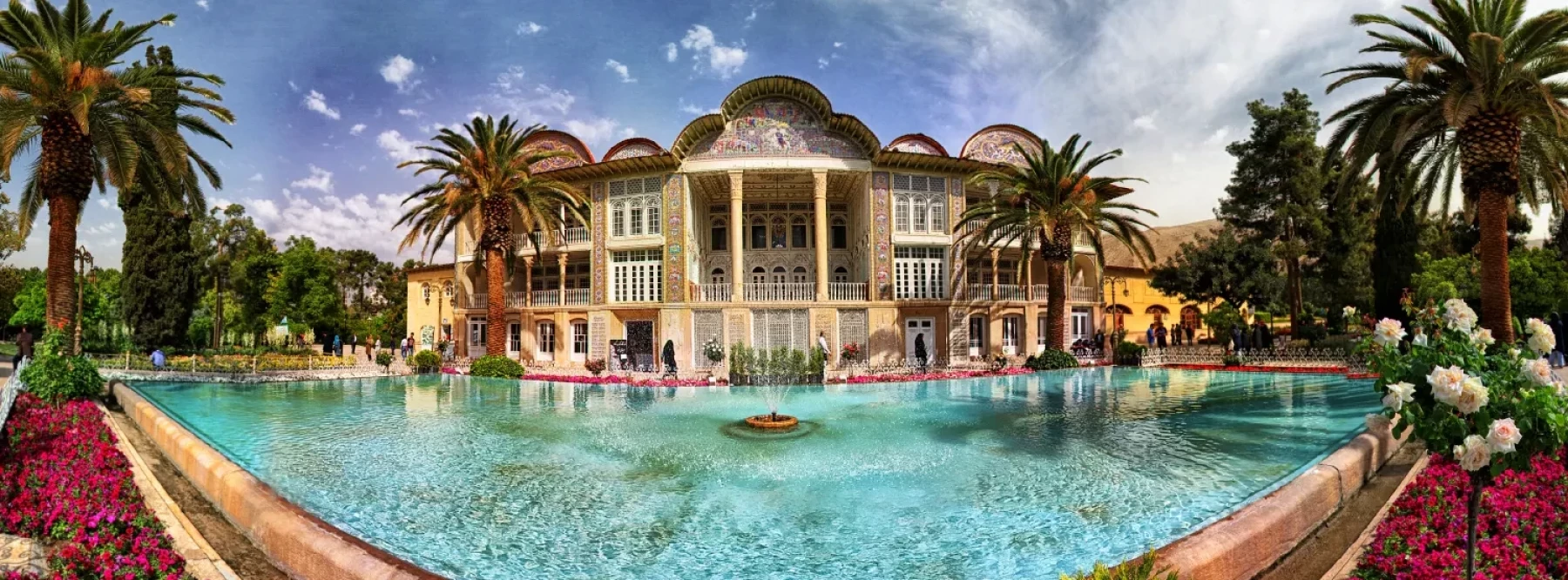The 14 essential things to do in Shiraz
Last update : 26/05/2024 15:40Summary
- To visit
-
- 1 - Nasir al-Mulk Mosque (Pink Mosque)
- 2 - Shah Cheragh Mosque
- 3 - Eram Garden
- 4 - Tomb of Hafez
- 5 - Tomb of Saadi
- 6 - Vakil Bazaar
- 7 - The Citadel of Karim Khan
- 8 - Saraye Moshir Bazaar
- 9 - Garden of Narenjestan-e Qavam
- 10 - Afifabad Garden
- 11 - Persepolis
- 12 - Naqsh-e Rostam and Naqsh-e Rajab
- 13 - Taste Persian cuisine
- 14 - Meet local people
- Shiraz - Where to Stay?
- Shiraz - How to get around?
- Shiraz - Best period
Traveling through the ancient city of Shiraz is a captivating experience where every corner tells a story centuries old. Narrow alleyways lined with historic buildings, lush gardens, and magnificent mosques transport visitors to another world, where history and culture intertwine harmoniously.
Picture yourself strolling through the heavenly gardens of Bagh-e Eram, where intoxicating scents of roses and exotic flowers envelop you. Dancing fountains and artistically decorated pavilions invite you to soak in the serenity of this enchanting place.
Next, you could lose yourself in the maze of alleys in the Vakil Bazaar, where colorful stalls overflow with hand-woven carpets, traditional crafts, and fragrant spices. The bustling atmosphere and authentic charm plunge you into the heart of the city's daily life.
Of course, no visit to Shiraz would be complete without exploring its architectural treasures, including the majestic Nasir al-Molk Mosque, also known as the "Pink Mosque," where the play of light through the stained glass creates a magical spectacle.
And what about the mausoleum of Hafez, the famous Persian poet, where visitors come to pay their respects at his tomb and ponder over his timeless verses?
Shiraz is more than just a travel destination; it's a sensory and spiritual experience that leaves an indelible imprint on the hearts of those fortunate enough to discover it.
1 - Nasir al-Mulk Mosque (Pink Mosque)
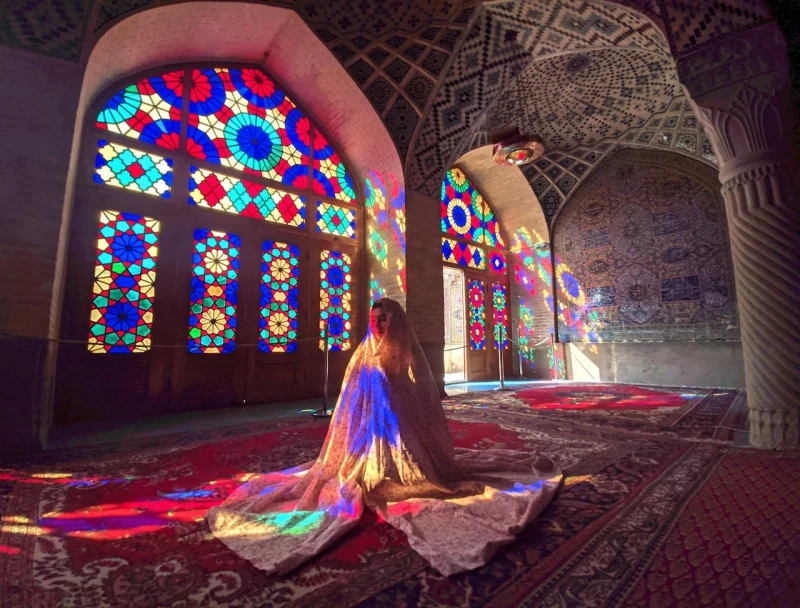
The Nasir al-Mulk Mosque, also known as the Pink Mosque, is a stunning mosque located in Shiraz, Iran. It was built in the late 19th century, between 1876 and 1888, during the Qajar dynasty, under the supervision of architect Mohammad Hasan-e-Memar and his son Mohammad Reza Kashi Paz-e-Shirazi.
What particularly distinguishes the Nasir al-Mulk Mosque is its impressive prayer hall, with windows adorned with colorful stained glass, creating a dazzling play of light inside during sunny hours. The vibrant colors and symmetry of floral and geometric patterns in the stained glass create a magical ambiance, making it one of the most famous attractions in Shiraz and even Iran.
The Nasir al-Mulk Mosque is often visited by tourists from around the world who come to admire its architectural beauty and extraordinary light effects, especially during sunrise.
 Our tips for getting the most out of your experience.
Our tips for getting the most out of your experience.
Here are some tips for visiting the Nasir al-Mulk Mosque:
-
Timing: Visit early in the morning, preferably at sunrise, to witness the stunning play of light through the stained glass windows. This is when the colors are most vibrant and the atmosphere is magical.
-
Clothing: As with any religious site in Iran, it's important to dress modestly. For both men and women, this means wearing clothing that covers your arms and legs. Women should also bring a scarf to cover their hair before entering the mosque.
-
Photography: The interior of the mosque is incredibly photogenic, especially during the morning hours when the sunlight filters through the windows. Make sure to bring your camera or smartphone to capture the mesmerizing colors and patterns.
-
Respect: Remember that the Nasir al-Mulk Mosque is a place of worship for Muslims. Be respectful of worshippers and maintain a quiet demeanor while inside the mosque.
-
Guided Tour: Consider joining a guided tour to learn more about the history and significance of the mosque. Guides can provide valuable insights and help you appreciate the architectural and cultural aspects of the site.
-
Plan Ahead: Check the mosque's opening hours before your visit, as they may vary depending on the day of the week and religious holidays.
-
Footwear: You'll likely need to remove your shoes before entering the prayer hall. Wear easy-to-remove footwear or socks for your visit.
-
Explore Surroundings: While in Shiraz, take the time to explore other nearby attractions, such as the Vakil Mosque, the Shiraz Citadel, and the Eram Garden, to make the most of your trip.
By following these tips, you can have a memorable and enjoyable experience visiting the Nasir al-Mulk Mosque.
2 - Shah Cheragh Mosque
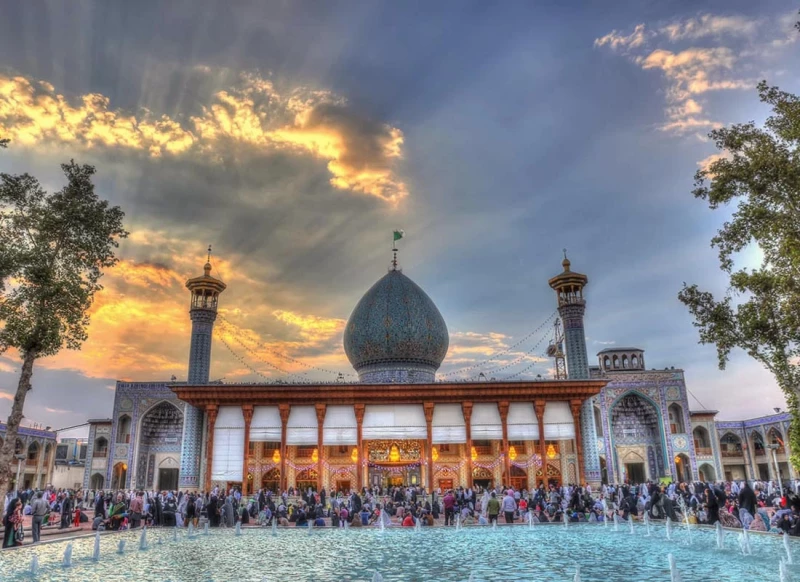
The Shah Cheragh Mosque is one of the most significant religious sites in Iran, located in the city of Shiraz. Its name literally translates to "King of the Light." The mosque houses the mausoleum of Sayyed Mir Ahmad, also known as Shah Cheragh, who was the brother of Imam Reza, one of the most revered Shiite imams.
The Shah Cheragh Mosque is renowned for its magnificent mosaics and ornate domes. It is an important pilgrimage site for Shiite believers, who come from far and wide to pay homage to Shah Cheragh and seek blessings from the site. Due to its architectural beauty and religious significance, the Shah Cheragh Mosque is also a major tourist destination in Iran. Visitors come to admire its architecture, Islamic art, and to learn more about the history and spirituality of the region.
 Our tips for getting the most out of your experience.
Our tips for getting the most out of your experience.
If you're planning to visit the Shah Cheragh Mosque in Shiraz, here are some tips for a pleasant experience:
-
Appropriate Attire: Like most religious sites in Iran, it's important to dress respectfully. Both men and women should wear loose, covering clothing, and women should also cover their heads with a scarf.
-
Opening Hours: Make sure to know the opening hours of the Shah Cheragh Mosque before your visit. Opening hours may vary depending on the day of the week and time of year.
-
Avoid Prayer Times: If you plan to visit during prayer times, be sure to respect the ongoing prayer and refrain from disrupting worshippers.
-
Tour Guides: Hiring a local tour guide can be a great idea to get detailed information about the history, architecture, and religious significance of the Shah Cheragh Mosque.
-
Photography: The Shah Cheragh Mosque is beautiful and you'll want to take pictures, but make sure to check the rules regarding photography inside the mosque. Some areas may be restricted.
-
Respectful Behavior: Be respectful towards worshippers and holy sites. Avoid speaking loudly, eating, or smoking inside the mosque.
-
Be Mindful of Security Rules: Follow the instructions of security personnel and be aware of your surroundings, especially if it's crowded.
-
Allocate Extra Time: The Shah Cheragh Mosque is a place rich in history and spirituality. Allow enough time to explore the different parts of the mosque and soak in the unique atmosphere of the place.
By following these tips, you'll be better prepared to fully enjoy your visit to the Shah Cheragh Mosque.
3 - Eram Garden
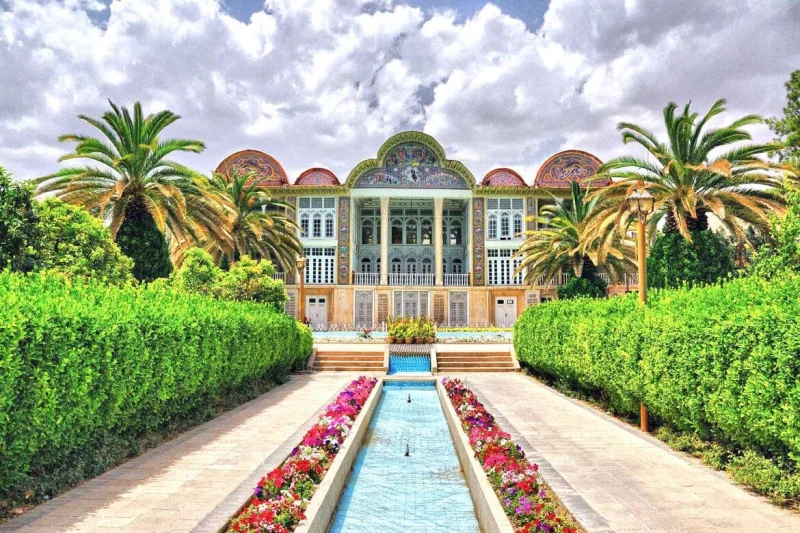
Eram Garden, also known as Bagh-e Eram, is a historic Persian garden located in Shiraz, Iran. It is one of the most famous and beautiful gardens in the country, renowned for its lush greenery, colorful flowers, and architectural features. The garden dates back to the 13th century, although most of its current layout and design were established during the Qajar period in the 19th century.
One of the main attractions of Eram Garden is the Eram Palace, a magnificent building that serves as a prime example of Persian architecture. The palace features intricate tile work, stunning mirror halls, and beautifully landscaped courtyards. The garden itself is adorned with numerous fruit trees, cypress trees, and flowering plants, creating a tranquil and picturesque environment.
Eram Garden has been inscribed as a UNESCO World Heritage Site, along with several other Persian gardens, under the collective title of the Persian Garden. It is a popular destination for both locals and tourists, offering a serene retreat from the hustle and bustle of city life and a glimpse into Iran's rich cultural heritage.
 Our tips for getting the most out of your experience.
Our tips for getting the most out of your experience.
If you're planning to visit the Eram Garden in Shiraz, here are some tips that might be helpful:
-
Visiting Hours: Make sure to check the opening hours of the garden before your visit to avoid disappointment. Opening hours can vary depending on the season and holidays.
-
Ideal Visiting Time: The best time to visit the garden is usually early in the morning or late in the afternoon when the light is soft and the garden is less crowded. This will also help you avoid the heat of the day, especially during the summer months.
-
Dress Code: As with most sites in Iran, it's recommended to wear modest and culturally respectful clothing when visiting the garden. Women should cover their arms and legs, and it's best to wear a scarf to cover the hair.
-
Hydration and Sun Protection: Make sure to bring plenty of water, especially during hot months. Don't forget to apply sunscreen and wear a hat to protect yourself from the sun.
-
Explore Leisurely: Take your time to leisurely explore the garden and admire its different features, including plants, fountains, and historical buildings. Feel free to wander along shaded pathways and take breaks to enjoy the serenity of the garden.
-
Photography: The garden offers plenty of opportunities for beautiful photographs. However, make sure to respect any rules regarding photography, especially concerning restricted areas or historical buildings.
-
Local Guides: If you want to learn more about the history and features of the garden, consider hiring a local guide. Guides can provide interesting and insightful information about the garden and its cultural significance.
By following these tips, you can fully enjoy your visit to Eram Garden and discover its beauty and tranquility.
4 - Tomb of Hafez
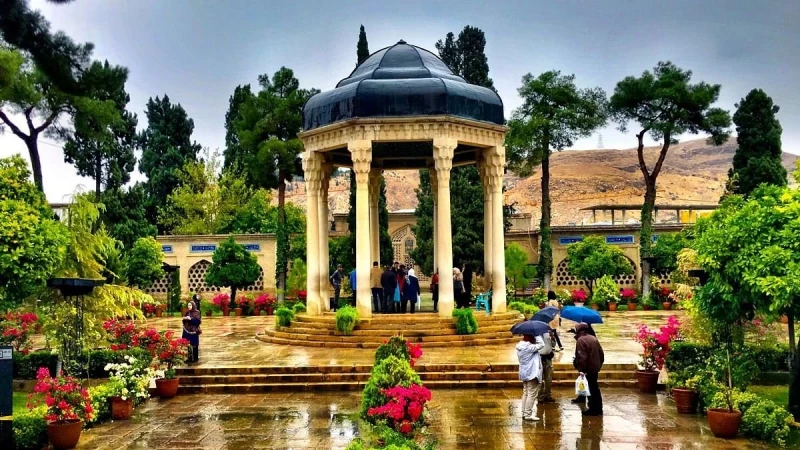
The "Tomb of Hafez" refers to the mausoleum of the famous Persian poet Hafez, located in Shiraz, Iran. Hafez, whose full name is Khwāja Shams-ud-Dīn Muhammad Hāfez-e Shīrāzī, is one of the most revered poets in Persian literature. He lived in the 14th century and is known for his lyrical verses, ghazals, and skilled use of metaphor and symbolism.
Hafez's tomb in Shiraz is a popular pilgrimage site for Iranians and poetry enthusiasts worldwide. It is situated in a garden called the "Hafezieh Garden," where visitors can stroll among trees, fountains, and pavilions, and contemplate the poet's verses engraved on the walls and stone slabs. The mausoleum itself is a beautiful building constructed in honor of Hafez, featuring traditional Persian architecture.
For many Iranians, visiting the Tomb of Hafez is a significant spiritual and cultural experience, and many consider it a symbol of Iran's rich poetic tradition. People often come to the mausoleum to recite Hafez's poems, seek inspiration, or simply reflect in the peace and beauty of the place.
 Our tips for getting the most out of your experience.
Our tips for getting the most out of your experience.
If you're planning to visit the Tomb of Hafez in Shiraz, here are some tips to make your visit more enjoyable and enriching:
-
Opening Hours: Check the opening hours of the mausoleum before your visit to ensure it's open to the public. It typically operates during the daytime, but there might be variations due to holidays or special events.
-
Appropriate Attire: Like most religious sites in Iran, it's recommended to wear modest and respectful clothing when visiting the Tomb of Hafez. This means avoiding tight or revealing clothing, and women should wear a headscarf to cover their hair.
-
Respect the Site: Hafez's mausoleum is a sacred place for many people, so be sure to respect the atmosphere and other visitors. Avoid excessive noise, eating, or drinking inside the mausoleum, and be respectful when taking photos.
-
Read Hafez's Poems: Before visiting the Tomb of Hafez, it can be helpful to read some of his poems to better appreciate his work and significance. You can even bring a collection of Hafez's poetry with you to reflect on his verses while exploring the mausoleum.
-
Take Your Time to Explore: The Hafezieh Garden surrounding the mausoleum is a peaceful and beautiful place to stroll and relax. Take your time to explore the gardens, admire the architecture, and soak in the atmosphere of the place.
-
Local Guides: If you want to learn more about the history and significance of the Tomb of Hafez, consider hiring the services of a local guide. They can provide valuable and in-depth information about the poet and the site itself.
By following these tips, you'll be able to fully enjoy your visit to the Tomb of Hafez and have a memorable and enriching experience.
5 - Tomb of Saadi
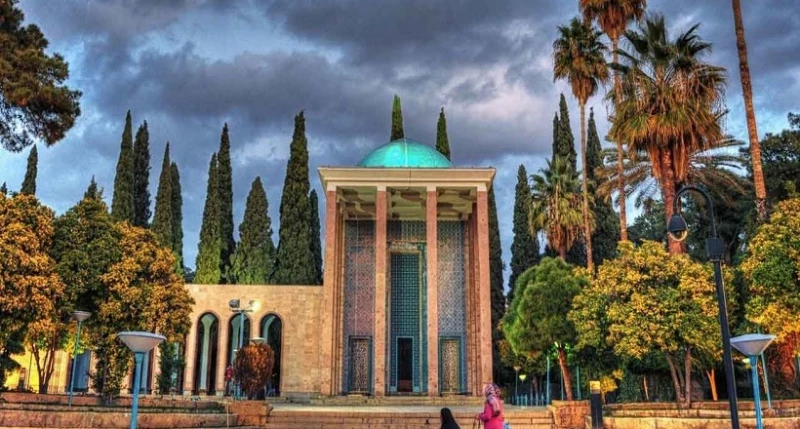
The "Tombeau de Saadi" refers to a famous literary work titled "Le Tombeau de Saadi" (The Tomb of Saadi), written by the French author Marcel Proust. This work is part of his larger collection of writings known as "Les Plaisirs et les Jours" (Pleasures and Days), which was published in 1896.
In "Le Tombeau de Saadi," Proust pays homage to the Persian poet Saadi Shirazi (often referred to simply as Saadi), who lived in the 13th century. The title alludes to Saadi's tomb in Shiraz, Iran, which Proust metaphorically uses as a symbol to explore themes of memory, love, and mortality. The text reflects Proust's deep engagement with literature, philosophy, and the human condition, characteristic of his later and more well-known work, "À la recherche du temps perdu" (In Search of Lost Time).
 Our tips for getting the most out of your experience.
Our tips for getting the most out of your experience.
If you're planning to visit the Tomb of Saadi, here are some tips:
-
Research Beforehand: Before visiting the Tomb of Saadi, it's helpful to do some research on Saadi himself and his significance in Persian literature. This will enrich your experience and understanding of the site.
-
Respect the Culture: Remember that the Tomb of Saadi is a place of cultural and historical significance. Respect local customs, dress modestly, and behave respectfully while visiting.
-
Guided Tour: Consider taking a guided tour of the tomb. A knowledgeable guide can provide valuable insights into the history and significance of the site, enhancing your experience.
-
Timing: Try to visit the Tomb of Saadi during the early morning or late afternoon to avoid crowds and the heat of the day, especially if you're visiting during the summer months.
-
Footwear: Since the tomb is a religious site, you may be required to remove your shoes before entering certain areas. Wear footwear that is easy to slip on and off.
-
Photography: While photography may be allowed in certain areas, always ask for permission before taking photos, especially if you're photographing individuals or religious objects.
-
Explore Surroundings: The Tomb of Saadi is often located within a larger complex or garden. Take some time to explore the surrounding area, as there may be additional points of interest nearby.
-
Bring Water and Sun Protection: Depending on the climate and time of year, the weather can be hot and sunny. Bring water and sun protection such as sunscreen, a hat, and sunglasses to stay comfortable during your visit.
-
Learn Some Persian Phrases: Learning a few basic Persian phrases can enhance your interactions with locals and show respect for the culture. Even simple greetings or expressions of gratitude can go a long way.
-
Be Open-Minded: Keep an open mind and be receptive to new experiences and perspectives during your visit to the Tomb of Saadi. Embrace the opportunity to learn and appreciate the cultural richness of the site.
6 - Vakil Bazaar
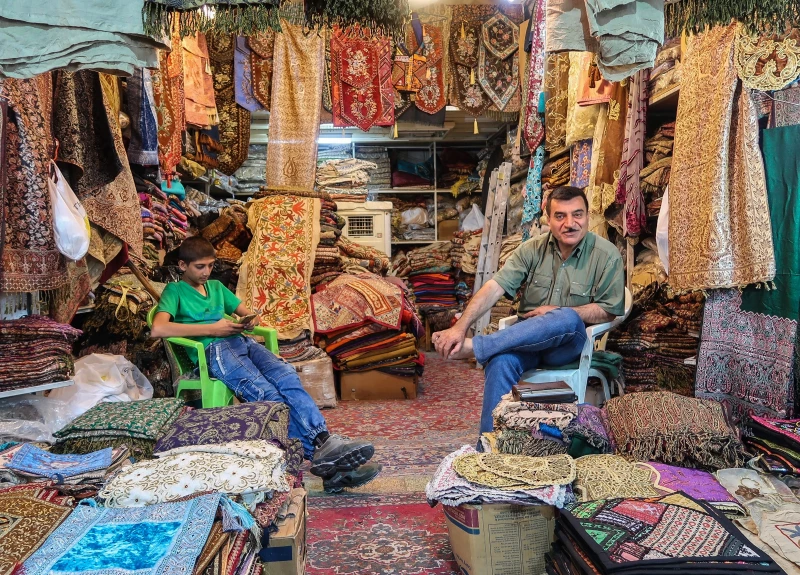
Le Bazar de Vakil, également connu sous le nom de Bazar Vakil, est l'un des marchés les plus célèbres et historiques de la ville de Shiraz, en Iran. Il a été construit au 18e siècle par Karim Khan, le fondateur de la dynastie Zand. Le bazar est renommé pour son architecture, qui présente de magnifiques plafonds voûtés, des corridors voûtés et des travaux de carrelage complexes.
Le Bazar Vakil est divisé en différentes sections, chacune dédiée à des marchandises spécifiques telles que les textiles, les épices, les tapis, les artisanats, et plus encore. Il a été un centre de commerce et d'échange pendant des siècles, attirant les habitants et les touristes.
Une des caractéristiques notables du bazar est sa conception, qui intègre un système de ventilation permettant de maintenir l'intérieur frais pendant les chaudes journées d'été. Cette ingéniosité architecturale reflète les compétences en ingénierie avancées de l'époque.
Les visiteurs du Bazar de Vakil peuvent s'immerger dans son ambiance animée, explorer ses ruelles étroites et faire des achats variés de produits traditionnels persans. Il offre également une occasion de découvrir le riche patrimoine culturel de l'Iran tout en profitant des paysages et des sons de ce marché historique.
 Our tips for getting the most out of your experience.
Our tips for getting the most out of your experience.
If you're planning to visit the Bazaar of Vakil in Shiraz, here are some tips to make the most of your experience:
-
Choose the Right Time: Try to visit the bazaar early in the morning or late in the afternoon to avoid crowds. This will also allow you to enjoy a quieter and more authentic atmosphere.
-
Wear Appropriate Clothing: Like in many traditional markets, it's advisable to wear modest and comfortable clothing, especially if you plan to visit more conservative areas of the bazaar.
-
Plan Roughly: The bazaar is vast and can be easily disorienting. Before you go, take a look at a map of the bazaar or mark down the places you want to visit so you don't get lost.
-
Negotiate Carefully: Price negotiation is an integral part of the shopping experience in the bazaar, but be respectful and only haggle if you're genuinely interested in making a purchase. Keep in mind that bargaining is part of the local culture, so have fun while getting a good deal.
-
Sample Local Specialties: Take the opportunity to taste local specialties and snacks offered by street vendors or in food stalls inside the bazaar. It's a great way to experience the local cuisine.
-
Be Mindful of Photography: While most people are open to being photographed, always ask for permission before taking pictures, especially if you're photographing individuals.
-
Explore the Surroundings: The Bazaar of Vakil is located near other attractions in Shiraz, such as the Nasir al-Mulk Mosque and the Eram Garden. Take the time to explore the surroundings and discover more about the city.
By following these tips, you'll be better prepared to enjoy your visit to the Bazaar of Vakil and make it a memorable experience.
7 - The Citadel of Karim Khan
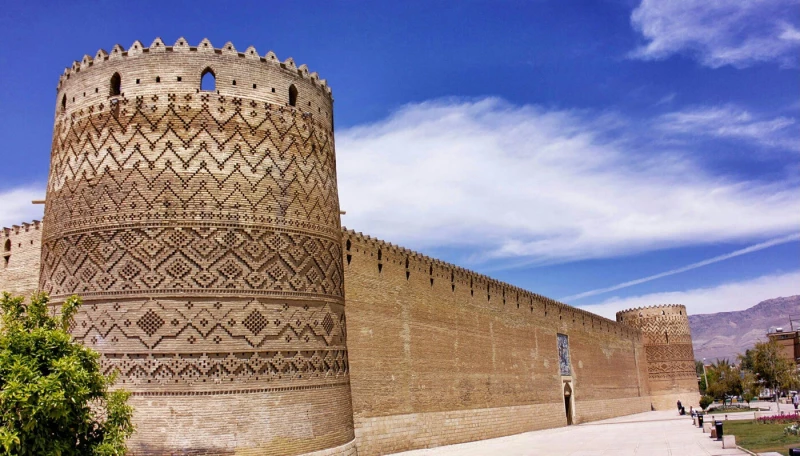
The Citadel of Karim Khan, also known as Arg-e Karim Khan, is a historic fortress located in the city of Shiraz, Iran. It was built in the 18th century by the founder of the Zand dynasty, Karim Khan. Construction of the citadel began in 1766 and was completed in 1767.
The Citadel of Karim Khan is an impressive example of Persian military architecture of the time. It is constructed of baked bricks and features four round towers at the corners, as well as high defensive walls. Inside the citadel, there are several buildings including the reception pavilion and Karim Khan's residential quarters, as well as halls for official meetings and audiences.
The architecture of the Citadel of Karim Khan is characterized by its use of traditional Persian artistic motifs, such as colorful glazed tiles and ceilings adorned with detailed paintings. The gardens and fountains also add to the beauty of the complex.
Today, the Citadel of Karim Khan is one of the main tourist attractions in Shiraz, attracting visitors from around the world to admire its remarkable architecture and learn more about the region's history under the Zand dynasty.
 Our tips for getting the most out of your experience.
Our tips for getting the most out of your experience.
If you're planning to visit the Citadel of Karim Khan in Shiraz, Iran, here are some useful tips to make your experience more enjoyable:
-
Opening and Closing Hours: Make sure to check the Citadel's opening hours before your visit. Opening hours may vary depending on the season and local holidays.
-
Best Time to Visit: Try to plan your visit early in the morning or late in the afternoon to avoid tourist crowds. Morning hours are often quieter and provide a better visiting experience.
-
Appropriate Attire: Like most historical sites in Iran, it's advisable to wear modest and culturally respectful clothing. Women should cover their hair with a scarf and wear loose-fitting clothing that covers the arms and legs.
-
Bring Water and Snacks: It can get hot during the day, especially in summer, so make sure to bring plenty of water to stay hydrated. You can also bring light snacks to recharge during your visit.
-
Tour Guide: Hiring a tour guide can be a great idea to learn more about the history and architecture of the Citadel of Karim Khan. Local guides are often very knowledgeable and can make your visit more enriching.
-
Photography: Don't forget to bring your camera to capture the stunning architectural details and surrounding landscapes. Make sure to respect the rules regarding photography inside the citadel, as some areas may have restrictions.
-
Thorough Exploration: Take the time to explore all corners of the citadel, including the towers, gardens, and interior buildings. There are often hidden treasures and interesting details to discover.
By following these tips, you'll be able to fully enjoy your visit to the Citadel of Karim Khan and learn more about its rich historical heritage.
8 - Saraye Moshir Bazaar
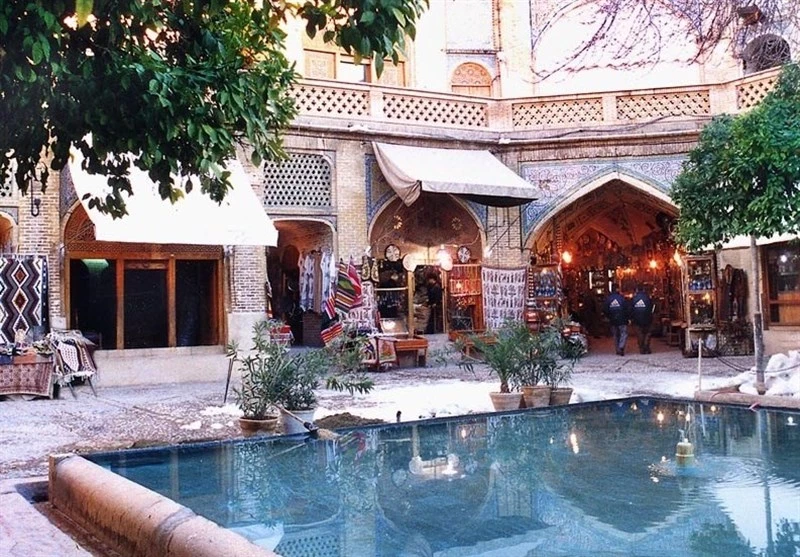
The Saraye Moshir Bazaar is a traditional market located in Shiraz, Iran. It stands as one of the city's most significant historical bazaars, with origins dating back several centuries. This bazaar offers an authentic glimpse into Iranian daily life and commerce.
Comprising a series of covered alleys, inner courtyards, and shops, the bazaar hosts a wide array of products, including Persian carpets, textiles, spices, antiques, jewelry, and more. As visitors stroll through the bazaar, they can also admire traditional Persian architecture, characterized by its arches, domes, and intricate decorative motifs.
Beyond shopping, the Saraye Moshir Bazaar serves as a social hub where locals gather to chat, enjoy tea, or simply wander. It's an essential destination for experiencing the culture and vibrant atmosphere of Shiraz.
9 - Garden of Narenjestan-e Qavam
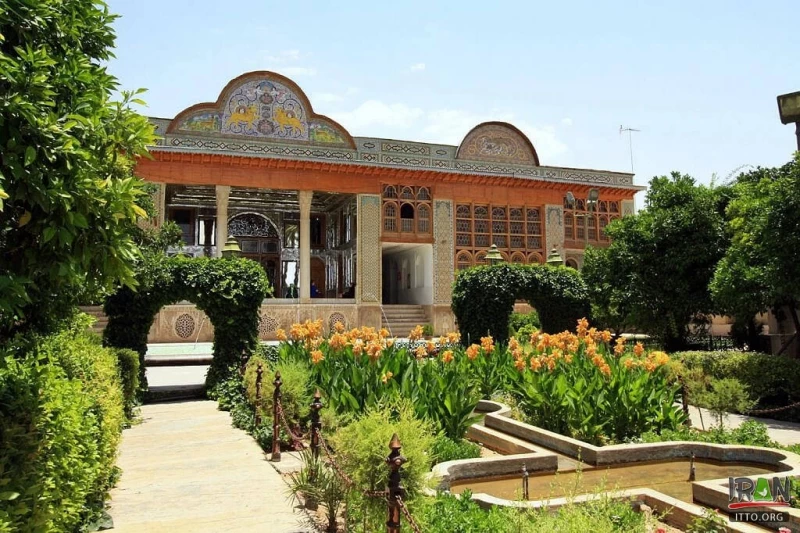
The Narenjestan-e Qavam Garden, also known as Narenjestan Garden, is a historical and cultural complex located in Shiraz, Iran. It dates back to the Qajar era and is renowned for its stunning architecture, lush gardens, and intricate design elements.
The garden is adorned with citrus trees (narenj in Persian, hence the name), flowers, and fountains, creating a tranquil and picturesque atmosphere. The architecture of the complex includes traditional Persian elements such as intricate tilework, delicate mirror work, and ornate wooden carvings.
One of the main attractions within the Narenjestan-e Qavam complex is the Qavam House, a magnificent mansion that served as the residence of the Qavam family, a prominent aristocratic family in Shiraz. The mansion features beautifully decorated rooms, reception halls, and courtyards, offering insight into the lifestyle of the elite during the Qajar period.
Visitors to Narenjestan-e Qavam Garden can explore the lush greenery, admire the architectural beauty of the mansion, and learn about the rich cultural heritage of Shiraz and Iran. It's a popular tourist destination and a must-visit for anyone interested in Persian history and architecture.
 Our tips for getting the most out of your experience.
Our tips for getting the most out of your experience.
If you're planning to visit the Narenjestan-e Qavam Garden in Shiraz, here are some tips to make your visit more enjoyable and rewarding:
-
Opening Hours: Make sure to check the garden's opening hours before planning your visit, as they may vary depending on the season and holidays.
-
Timing: Try to visit the garden early in the morning or late in the afternoon to avoid the heat of the day and enjoy the soft light for photography.
-
Dress Code: As with most historical sites in Iran, modest dress is recommended, covering arms, legs, and wearing a headscarf for women.
-
Explore with a Guide: Hiring a local guide can provide valuable insights into the history, architecture, and anecdotes related to the garden, enhancing your experience.
-
Take Your Time: The garden is vast and offers many picturesque corners to explore. Take your time to stroll through the alleys, admire architectural details, and relax in the green spaces.
-
Photography: Feel free to take photos, but make sure to respect any rules and restrictions on photography inside the buildings if they are in place.
-
Stay Hydrated: Bring a water bottle to stay hydrated during your visit, especially during the warmer months.
-
Enjoy Local Culture: Take advantage of your visit to taste local specialties at cafes or restaurants near the garden.
By following these tips, you can maximize your experience visiting the Narenjestan-e Qavam Garden and make it a memorable moment.
10 - Afifabad Garden
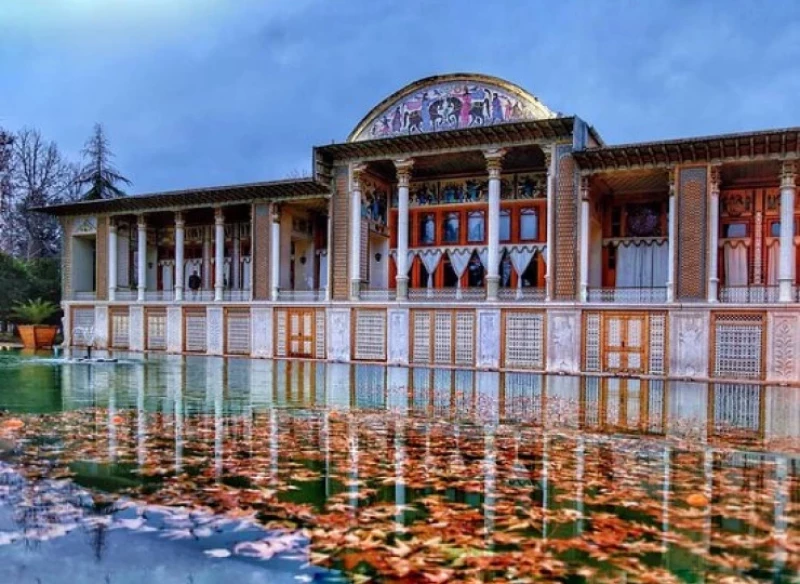
The Afifabad Garden is a historic garden located in Shiraz, Iran. It is also known as Bagh-e Afifabad in Persian. This garden dates back to the Zand dynasty in the 18th century and was further developed during the Qajar dynasty.
The Afifabad Garden is renowned for its beauty, fountains, pavilions, and lush trees. It also houses the Afifabad Palace, which was once the summer residence of the regional governor. Today, the palace hosts the Karim Khan War Museum and displays a collection of historical artifacts related to that period.
Visitors to the Afifabad Garden can stroll through its shaded pathways, admire traditional Persian architecture, and enjoy the tranquil atmosphere of the surroundings. It is one of Shiraz's popular tourist attractions and a place where locals often visit to relax and unwind.
 Our tips for getting the most out of your experience.
Our tips for getting the most out of your experience.
When visiting the Afifabad Garden in Shiraz, Iran, here are some helpful tips to make the most of your experience:
-
Visiting Hours: Try to plan your visit early in the morning or late in the afternoon to avoid the hottest times of the day, especially in summer.
-
Dress Code: Make sure to wear appropriate and modest clothing in accordance with local customs. This may include long-sleeved shirts and long pants for both men and women, as well as a scarf or shawl to cover women's hair.
-
Hydration: Bring a water bottle to stay hydrated during your visit, especially if it's hot.
-
Sun Protection: Don't forget to apply sunscreen and wear a hat or cap to protect yourself from the sun.
-
Camera: Afifabad Garden offers many opportunities for beautiful photos. Be sure to bring your camera or smartphone to capture memorable moments.
-
Take Your Time Exploring: Take your time to explore the garden, enjoy the beauty of the architecture, fountains, and landscapes. Don't rush, but take the time to soak in the peaceful atmosphere.
-
Visit the Museum: Don't miss the Karim Khan War Museum located in the Afifabad Palace to learn more about the region's history.
-
Respect the Environment: Be mindful not to damage plants or structures in the garden and to adhere to any rules in place.
By following these tips, you'll be able to fully enjoy your visit to Afifabad Garden in Shiraz and make it a memorable experience.
11 - Persepolis
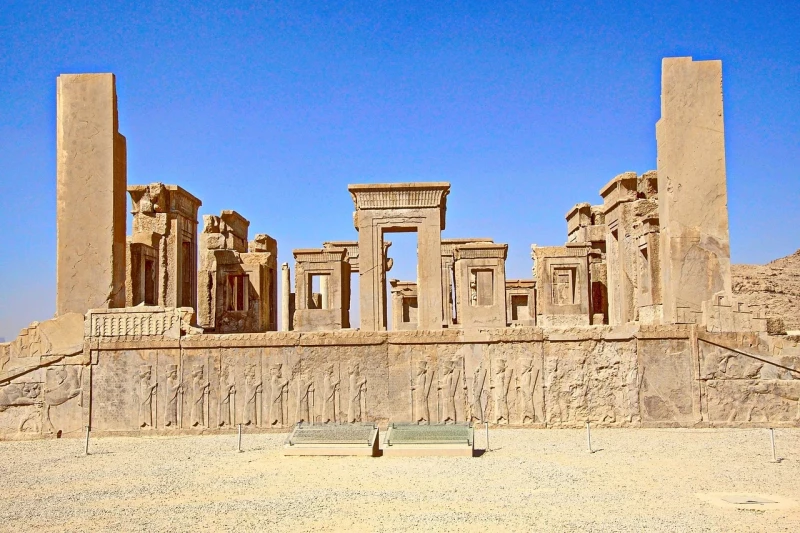
"Persepolis" is the name of an ancient city located in southwestern Iran, near the modern city of Shiraz. It is a major archaeological site that was once the capital of the Achaemenid Persian Empire. Founded by Darius I in 518 BCE, Persepolis served as the political and ceremonial center of the Persian Empire for about 200 years, until it was burned by Alexander the Great in 330 BCE. The site of Persepolis is now a major tourist attraction in Iran, and it is listed as a UNESCO World Heritage Site.
Persepolis is located approximately 60 kilometers northeast of Shiraz, Iran. There are several ways to travel from Shiraz to Persepolis:
-
Private car or taxi: This is the most convenient and flexible option. You can either rent a car or take a taxi from Shiraz to Persepolis. Make sure to agree on a price with the driver before departure.
-
Public transportation: There are buses and minibusses connecting Shiraz to Persepolis. You can take a public bus from Shiraz's bus station to Marvdasht, and then either a taxi or another local bus to reach Persepolis.
-
Organized tours: Many travel agencies in Shiraz offer organized tours to Persepolis. These tours often include transportation from your accommodation in Shiraz as well as a tour guide to accompany you and provide information about the site.
Whichever mode of transportation you choose, make sure to check departure and arrival schedules as well as fares, and allocate enough time to explore the archaeological site of Persepolis once you arrive.
 Our tips for getting the most out of your experience.
Our tips for getting the most out of your experience.
Visiting Persepolis is a fascinating and enriching experience. Here are some tips to make your visit more enjoyable and fulfilling:
-
Allocate enough time: Persepolis is a vast site with many ruins to explore. Plan to spend at least a few hours to visit the site and appreciate its grandeur fully.
-
Wear comfortable shoes: You'll be walking on uneven and sometimes rocky paths, so comfortable and sturdy shoes are recommended to avoid injuries and fully enjoy the visit.
-
Bring water and snacks: It can get hot, especially in summer, so make sure to bring enough water to stay hydrated during your visit. Light snacks can also be handy to recharge your energy.
-
Listen to a guide or use an audio guide: For a more informative experience, consider hiring a guide on-site or using an audio guide to learn more about the history and architecture of Persepolis during your visit.
-
Respect local rules and culture: Be sure to respect the site's rules and the local culture during your visit. This includes wearing modest clothing, respecting restricted areas, and behaving respectfully towards other visitors and the site itself.
-
Enjoy panoramic viewpoints: Some parts of Persepolis offer spectacular panoramic views of the site and the surrounding area. Take the time to stop and admire these breathtaking vistas.
-
Explore the surroundings: In addition to Persepolis, the surrounding region is filled with other interesting historical and cultural sites, such as Naqsh-e Rustam and Pasargadae. If time permits, consider exploring these sites as well.
By following these tips, you can make the most out of your visit to Persepolis and turn it into an unforgettable experience.
12 - Naqsh-e Rostam and Naqsh-e Rajab
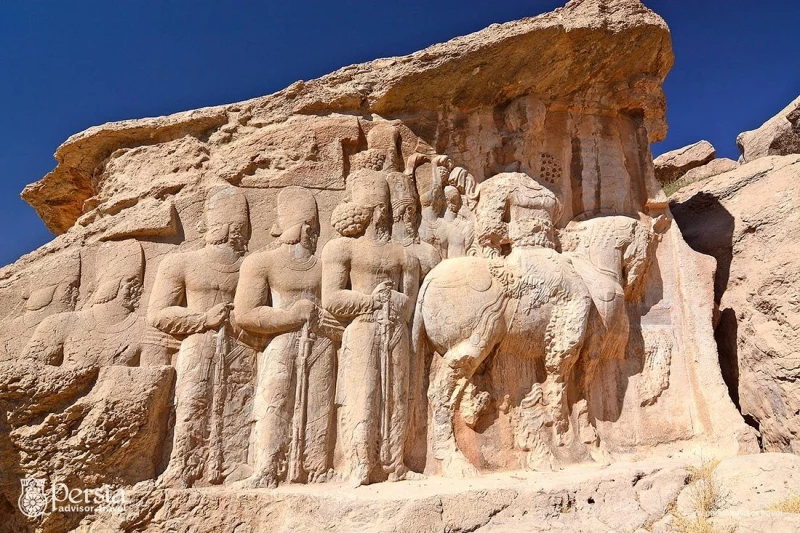
Naqsh-e Rostam and Naqsh-e Rajab are two archaeological sites located near Persepolis in Iran, both of which are significant historical and cultural landmarks.
-
Naqsh-e Rostam: This site is an ancient necropolis located about 12 kilometers northwest of Persepolis, near the city of Marvdasht. Naqsh-e Rostam features a series of rock-cut tombs belonging to the Achaemenid kings, including Darius the Great, Xerxes I, Artaxerxes I, and Darius II. These tombs are carved into the cliffs and are highly decorated with reliefs and inscriptions. Additionally, there are seven large rock reliefs at the site, depicting various scenes including battles and royal ceremonies. Naqsh-e Rostam is considered one of the most important archaeological sites in Iran and provides valuable insights into the ancient Persian civilization.
-
Naqsh-e Rajab: Located about 3 kilometers northwest of Naqsh-e Rostam, Naqsh-e Rajab is another archaeological site with rock reliefs and inscriptions. It features several Sassanian rock reliefs carved into the cliff face, depicting Sassanian kings and important historical events. These reliefs are notable for their intricate detail and provide valuable information about the Sassanian Empire, which ruled Persia from the 3rd to the 7th century CE. Naqsh-e Rajab, like Naqsh-e Rostam, is an important site for understanding the history and culture of ancient Persia.
Both Naqsh-e Rostam and Naqsh-e Rajab are popular tourist destinations and are recognized as UNESCO World Heritage Sites, attracting visitors from around the world who come to marvel at their historical significance and architectural beauty.
 Our tips for getting the most out of your experience.
Our tips for getting the most out of your experience.
If you're planning to visit Naqsh-e Rostam and Naqsh-e Rajab in Iran, here are some useful tips:
-
Plan your visit: Make sure to plan your visit in advance, considering the opening hours and weather conditions. The sites are generally open year-round, but it's good to check the timings before you go.
-
Transportation: The sites are located near the city of Marvdasht, about 12 kilometers from Persepolis. You can get there by taxi, rental car, or using public transportation if available.
-
Optimal visiting hours: To avoid crowds and intense heat, it's recommended to visit early in the morning or late in the afternoon. This will also allow you to enjoy the sites in a quieter atmosphere.
-
Appropriate attire: As with most historical sites in Iran, it's important to wear modest clothing that covers shoulders, arms, and legs. Women should also wear a headscarf to cover their hair.
-
Hydration and sun protection: Make sure to bring plenty of water, especially in hot weather, as well as sunscreen, a hat, and sunglasses to protect yourself from UV rays.
-
Local guides: Hiring a local guide can be beneficial to get in-depth information about the history and significance of the sites. Many guides speak English and can enhance your visiting experience.
-
Respect site rules: Be sure to follow the rules and regulations of the site, including areas where photography is allowed and where it's prohibited. Also, be respectful to other visitors and the environment.
By following these tips, you'll be able to fully enjoy your visit to Naqsh-e Rostam and Naqsh-e Rajab and learn more about the fascinating history of these remarkable archaeological sites in Iran.
13 - Taste Persian cuisine
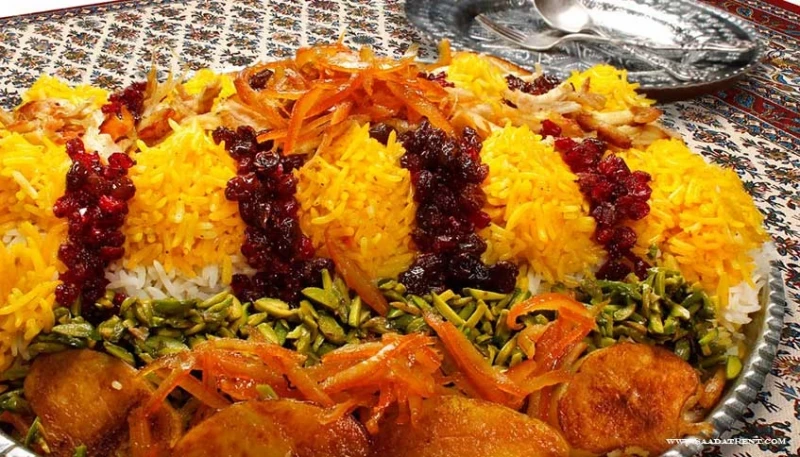
Tasting Persian cuisine in Shiraz, Iran, can be a delightful experience, as the city is renowned for its rich culinary heritage. Here are some dishes you might want to try:
-
Kebabs: Shiraz is famous for its succulent kebabs, particularly koobideh (ground meat kebab) and joojeh (chicken kebab). These are usually served with rice and grilled tomatoes.
-
Fesenjan: A delicious stew made with ground walnuts, pomegranate paste, and chicken or duck. It has a unique sweet and sour flavor.
-
Ghormeh Sabzi: A popular Persian herb stew made with a variety of fresh herbs, red beans, and lamb or beef. It's often served with rice and has a hearty, aromatic taste.
-
Tahchin: A savory rice cake layered with chicken, yogurt, and saffron. It's a specialty dish often served at special occasions.
-
Ash-e Reshteh: A hearty Persian noodle soup made with beans, herbs, and noodles. It's a comfort food enjoyed especially during the colder months.
-
Baghali Polo: A flavorful rice dish cooked with dill and broad beans, usually served with lamb shank or chicken.
-
Shirazi Salad: A refreshing salad made with diced cucumbers, tomatoes, onions, and mint, dressed with lime juice and olive oil.
-
Halva: A traditional Persian dessert made from sesame paste or flour, sweetened with honey or sugar, and flavored with saffron, rosewater, or cardamom.
-
Faloodeh: A refreshing Persian dessert made from thin vermicelli noodles mixed with rose water, sugar syrup, and lime juice, often served with a scoop of ice cream.
-
Doogh: A yogurt-based drink mixed with water, salt, and dried mint. It's a popular beverage to accompany meals, especially during hot weather.
These are just a few examples of the delicious dishes you can savor while exploring Persian cuisine in Shiraz. Be sure to also explore local eateries and street food vendors to discover even more culinary delights.
14 - Meet local people
Meeting local people in Shiraz, Iran, can be a enriching experience that allows you to better understand the culture, traditions, and lifestyle of the local population. Here are some tips to facilitate interactions with locals in Shiraz:
-
Local markets: Markets like the Vakil Bazaar in Shiraz are vibrant places where you can interact with locals while shopping. Feel free to strike up conversations with vendors, taste local products, and ask questions about regional specialties.
-
Cafés and tea houses: Cafés and tea houses are popular socializing spots in Iran. Iranians enjoy gathering to chat, share a light meal, or enjoy tea. Try sitting at a communal table and engage in a casual conversation.
-
Historical sites: When visiting historical sites like the Nasir al-Mulk Mosque or the Hafez Mausoleum, you may encounter locals who are also exploring these places. Be open to interaction and use these locations as opportunities for informal discussions.
-
Cultural events: Check the local calendar for cultural events, festivals, or celebrations happening during your visit. Participating in these activities can provide a natural opportunity to meet locals.
-
Cooking classes: Some establishments offer cooking classes where you can learn to prepare traditional Iranian dishes. It's an excellent chance to interact with locals, learn cooking techniques, and share a meal together.
-
Local social networks: Use social media to search for local events or groups that may organize meetups between locals and visitors. Apps like Meetup can also be helpful.
-
Be respectful of local customs: When interacting with locals, be respectful of customs and local decency. Iranians are generally welcoming, but it's important to behave in a respectful manner.
In general, a friendly and open approach is key to establishing connections with locals in Shiraz. Learn a few basic phrases in Persian, show interest in their culture, and be ready to share your own experiences. You might find yourself building authentic connections with local people.
Shiraz - Where to Stay?
When visiting Shiraz, Iran, you have several options for accommodation depending on your preferences and budget:
-
Luxury Hotels: Shiraz boasts several five-star hotels offering high-quality service and luxurious facilities. Popular options include the Shiraz Grand Hotel, Zandiyeh Hotel, and Chamran Grand Hotel.
-
Boutique Hotels: If you prefer a more intimate and personalized experience, consider staying at one of Shiraz's many boutique hotels. These establishments often provide superior accommodation in unique and picturesque environments.
-
Traditional Guesthouses (Khanéh Sonnati): For a more authentic experience, consider staying in a traditional Iranian guesthouse. These establishments offer a warm and friendly atmosphere, providing an opportunity to get closer to the local culture.
-
Vacation Rentals: If you prefer independent accommodation, you can look for vacation rentals or apartments for rent in Shiraz. This option can be ideal for families or groups traveling together who want more space and privacy.
-
Hostels: For budget travelers or those seeking a more social atmosphere, hostels are an affordable option in Shiraz. You'll find several well-maintained hostels offering dormitories and private rooms at reasonable prices.
Make sure to book your accommodation in advance, especially during the high tourist season, to ensure availability and secure the best possible rates.
Shiraz - How to get around?
To get around and explore Shiraz, Iran, here are some options to consider:
-
Taxis: Taxis are abundant in Shiraz and provide a convenient way to travel around the city. You can hail a taxi on the street or find them at designated taxi stands. Make sure to negotiate the fare before getting in or use the meter if available.
-
Public Transportation: Shiraz also has a public transportation system, including buses and minibusses, which cover much of the city. Fares are generally affordable, but schedules may be less reliable. You can obtain information about bus routes from locals or tourist information offices.
-
Rental Car: If you prefer greater independence and flexibility with your own vehicle, consider renting a car. Many car rental agencies are available in Shiraz, and driving in the city is generally manageable, although traffic can be dense at times.
-
Walking: Many of Shiraz's tourist attractions, such as Eram and Bagh-e Narenjestan Gardens, as well as Nasir al-Mulk Mosque, are within walking distance if you're staying in the city center. Walking is often a pleasant way to explore the city and its bustling streets.
-
Guided Tours: For a more organized and informative experience, you can consider joining guided tours of Shiraz. Many travel agencies offer tours that include the city's main attractions, often with a local guide providing historical and cultural insights.
Whichever option you choose, make sure to plan your transportation in advance to maximize your time and comfort while visiting Shiraz.
Shiraz - Best period
The best time to visit Shiraz depends on your preferences regarding climate and local events. Here's some information to help you plan your visit:
-
Spring (March to May): Spring is generally considered the best time to visit Shiraz. The temperatures are pleasant, typically around 20-25°C (68-77°F), and the city's gardens are in full bloom, making the city even more beautiful. It's also the time when the Iranian New Year festival, Nowruz, is celebrated, bringing a festive atmosphere to the city.
-
Autumn (September to November): Autumn is another good time to visit Shiraz. Temperatures start to cool down after the summer heat, and the city's gardens and parks still retain much of their greenery. It's also a less crowded time for tourists compared to spring.
-
Summer (June to August): Summers in Shiraz can be very hot, with temperatures often exceeding 35°C (95°F) or higher. If you visit Shiraz during this time, make sure to stay hydrated regularly and wear light clothing. Despite the heat, you can still enjoy the coolness of the gardens and shaded areas.
-
Winter (December to February): Winters in Shiraz are mild but can be rainy and sometimes cold, with temperatures around 5-10°C (41-50°F). While temperatures are cooler, this time of year can offer unique experiences, such as the opportunity to see the surrounding mountains covered in snow.
In summary, spring and autumn are generally considered the best seasons to visit Shiraz due to the pleasant temperatures and local events. However, if you can tolerate the summer heat or cooler winter weather, you can still enjoy the city during those times. Just make sure to check the weather forecast and plan accordingly.
